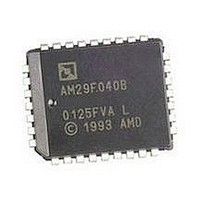AM29F040B-120JF Spansion Inc., AM29F040B-120JF Datasheet - Page 16

AM29F040B-120JF
Manufacturer Part Number
AM29F040B-120JF
Description
Flash Memory IC
Manufacturer
Spansion Inc.
Datasheet
1.AM29F040B-120JF.pdf
(36 pages)
Specifications of AM29F040B-120JF
Memory Size
4Mbit
Memory Configuration
512K X 8
Ic Interface Type
Parallel
Access Time
120ns
Memory Case Style
PLCC
No. Of Pins
32
Operating Temperature Range
-40°C To +85°C
Termination Type
SMD
Lead Free Status / RoHS Status
Lead free / RoHS Compliant
Available stocks
Company
Part Number
Manufacturer
Quantity
Price
Company:
Part Number:
AM29F040B-120JF
Manufacturer:
ESMT
Quantity:
2 140
WRITE OPERATION STATUS
The device provides several bits to determine the sta-
tus of a write operation: DQ2, DQ3, DQ5, DQ6, and
DQ7. Table
the functions of these bits. DQ7 and DQ6 each offer a
method for determining whether a program or erase
operation is complete or in progress. These three bits
are discussed first.
DQ7: Data# Polling
The Data# Polling bit, DQ7, indicates to the host sys-
tem whether an Embedded Algorithm is in progress or
completed, or whether the device is in Erase Suspend.
Data# Polling is valid after the rising edge of the final
WE# pulse in the program or erase command
sequence.
During the Embedded Program algorithm, the device
outputs on DQ7 the complement of the datum pro-
grammed to DQ7. This DQ7 status also applies to
programming during Erase Suspend. When the Em-
bedded Program algorithm is complete, the device
outputs the datum programmed to DQ7. The system
must provide the program address to read valid status
information on DQ7. If a program address falls within a
protected sector, Data# Polling on DQ7 is active for ap-
proximately 2 µs, then the device returns to reading
array data.
During the Embedded Erase algorithm, Data# Polling
produces a “0” on DQ7. When the Embedded Erase al-
gorithm is complete, or if the device enters the Erase
Suspend mode, Data# Polling produces a “1” on DQ7.
This is analogous to the complement/true datum output
described for the Embedded Program algorithm: the
erase function changes all the bits in a sector to “1”;
prior to this, the device outputs the “complement,” or
“0.” The system must provide an address within any of
the sectors selected for erasure to read valid status in-
formation on DQ7.
After an erase command sequence is written, if all sec-
tors selected for erasing are protected, Data# Polling
on DQ7 is active for approximately 100 µs, then the de-
vice returns to reading array data. If not all selected
sectors are protected, the Embedded Erase algorithm
erases the unprotected sectors, and ignores the se-
lected sectors that are protected.
When the system detects DQ7 has changed from the
complement to true data, it can read valid data at
DQ7–DQ0 on the following read cycles. This is be-
cause DQ7 may cha nge asynch rono usly with
DQ0–DQ6 while Output Enable (OE#) is asserted low.
The Data# Polling Timings (During Embedded Algo-
14
5
and the following subsections describe
D A T A
Am29F040B
S H E E T
rithms) figure in the
illustrates this.
Table
Figure
Notes:
1. VA = Valid address for programming. During a sector
2. DQ7 should be rechecked even if DQ5 = “1” because
No
erase operation, a valid address is an address within any
sector selected for erasure. During chip erase, a valid
address is any non-protected sector address.
DQ7 may change simultaneously with DQ5.
5
3
shows the outputs for Data# Polling on DQ7.
shows the Data# Polling algorithm.
Figure 3. Data# Polling Algorithm
Read DQ7–DQ0
Read DQ7–DQ0
DQ7 = Data?
DQ7 = Data?
Addr = VA
Addr = VA
DQ5 = 1?
START
FAIL
No
Yes
No
“AC Characteristics”
21445E5 November 1, 2006
Yes
Yes
PASS
section
















